Basic concepts of Huffman
Path: the branch from one node to another in the tree forms the path between the two nodes
Node path length: the number of branches on the path between two nodes
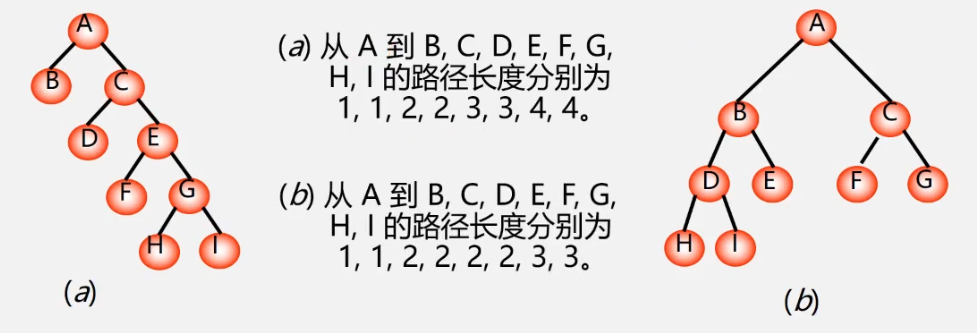
Path length of tree: the sum of the path length from the tree root to each node is recorded as TL
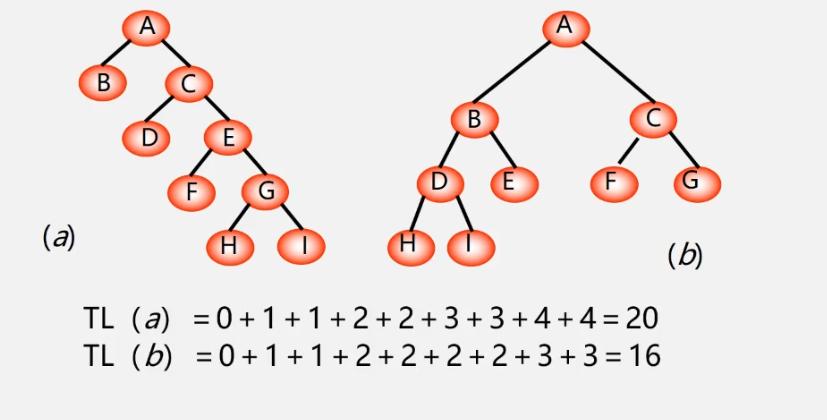
Weight: assign a node in the tree to a value with a certain meaning, then this value is called the weight of the node
Weighted path length of a node: the product of the path length from the root node to the node and the weight of the node
Weighted path length of tree (WPL): the sum of weighted path lengths of all leaf nodes in the tree
Record as:
W
P
L
=
∑
i
=
0
k
w
k
l
k
WPL=\sum_{i=0}^{k} w_ k l_k
WPL=i=0∑kwklk
ω
\omega
ω—— Weight
l
k
l_k
lk -- path length from node to root
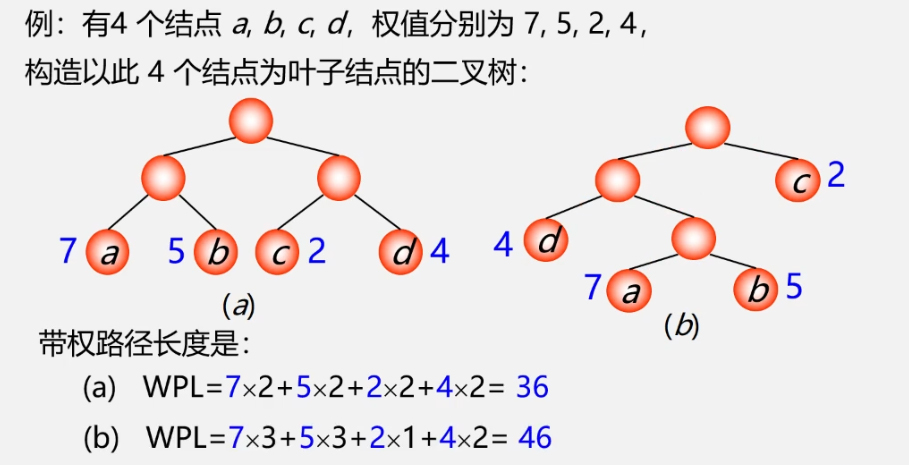
Huffman tree: optimal tree - the tree with the shortest weighted path length (WPL)
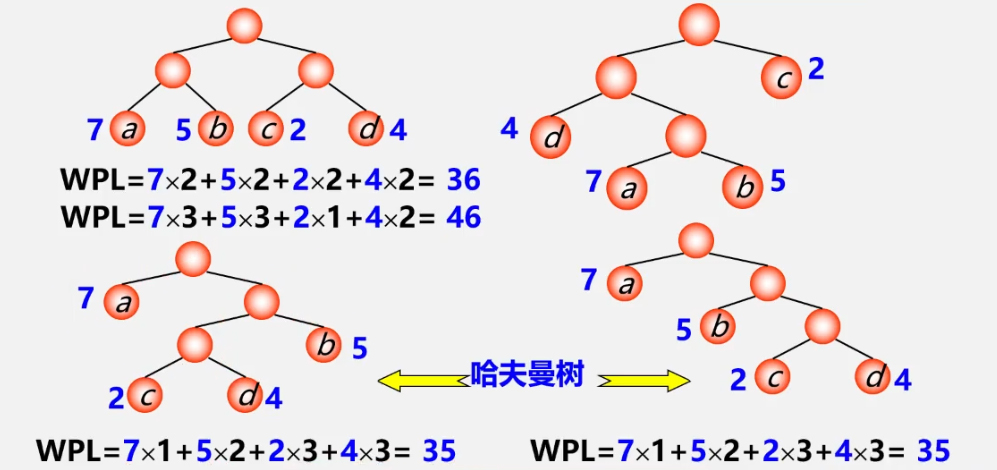
- A full binary tree is not necessarily a Huffman tree
- The more powerful the leaf in the Huffman tree, the closer it is to the root
- Huffman trees with the same weighted nodes are not unique
Construction algorithm of Huffman tree
Greedy algorithm: to construct Huffman tree, first select the leaf node with small weight
Huffman algorithm (method of constructing Huffman tree)
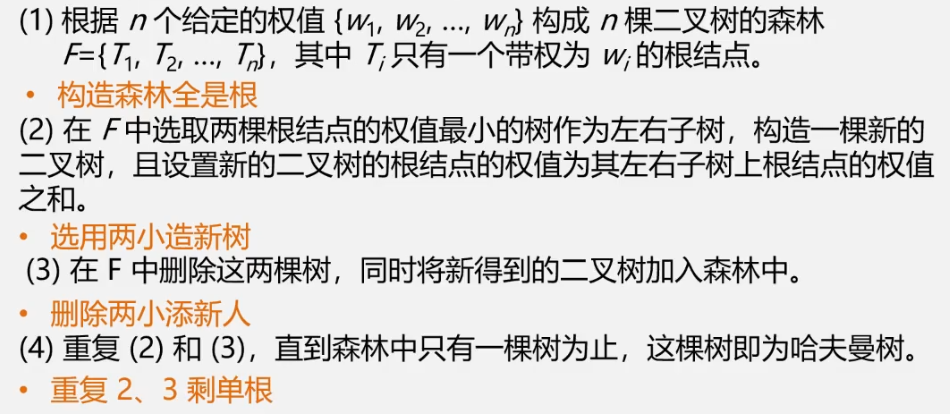
Pithy formula:
- Structural forests are all roots;
- Select two small trees to build new trees;
- Delete two new people
- Repeat 2 and 3, leaving a single piece
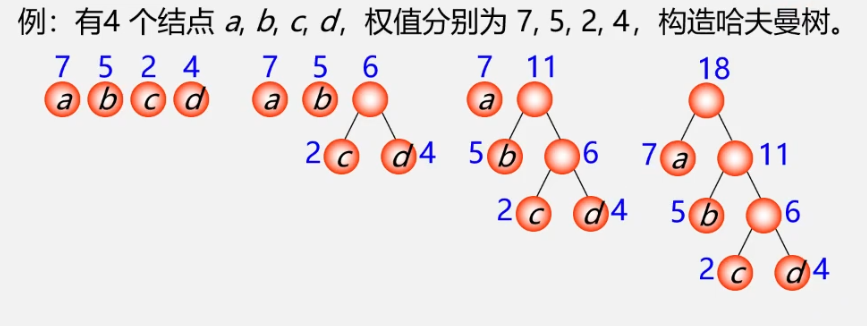
The degree of the node of Huffman tree is 0 or 2, and there is no node with degree 1;
The Huffman tree with n leaf nodes has 2n-1 nodes;
The forest containing N trees must be merged n-1 times to form Huffman tree, with n-1 new nodes;

Summary:
- In Huffman algorithm, there are N binary trees at the beginning, which need to be merged n-1 times to finally form Huffman tree
- After n-1 merging, n-1 new nodes are generated, and these n-1 new nodes are branch nodes with two children
It can be seen that the Huffman tree has n+n-1 = 2n-1 nodes, and the degree of all its branch nodes is not 1
Implementation of Huffman tree construction algorithm
Using sequential storage structure -- one-dimensional structure array
Node type definition:
typedef struct{
int weight;
int parent, lch, rch;
}HTNode, *HuffmanTree;
The Huffman tree has 2n-1 nodes in total, does not use 0 subscript, and the array size is 2n
For example, if the weight of the first node is 5, it can be expressed as H [i] weight = 5;
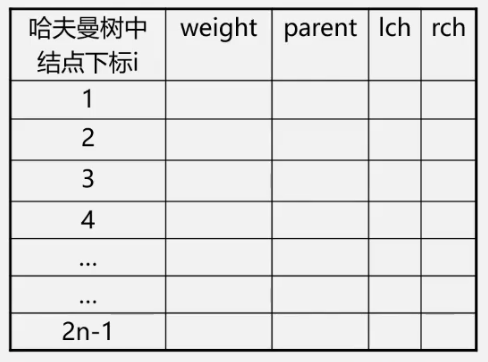
Example: n = 8, weight W = {7, 19, 2, 6, 32, 3, 21, 10}, construct Huffman tree
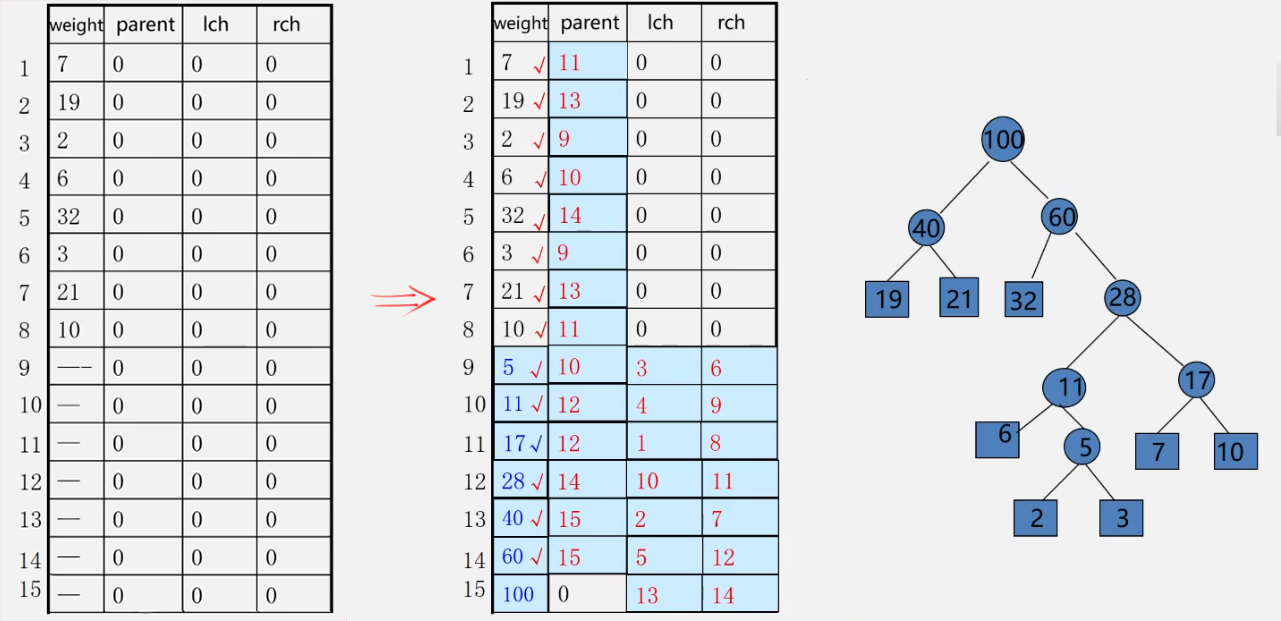
- Initialize HT [1... 2n-1]: lch = rch = parent = 0;
- Enter the initial n leaf nodes: set the weight value of HT[1... N]
- Perform the following n-1 merges to generate n-1 nodes HT[i], i = n+1... 2n-1
a) in HT[1... i-1, select two nodes HT[s1] and HT[s2] with the smallest weight that have not been selected (from the nodes with parent==0), and s1 and s2 are the subscripts of the two smallest nodes;
b) modify the parent values of HT[s1] and HT [S2]: HT[s1] parent=i; HT[s2].parent = i;
c) modify the newly generated HT[i]:
1) HT[i].weight = HT[s1].weigth + HT[s2].weight;
2) HT[i].lch = s1; HT[i].rch = s2;
//Constructing Huffman tree -- Huffman algorithm
void CreatHuffmanTree(HuffmanTree &HT, int n){
if(n <= 1) return;
m = 2 * n - 1; //The array has 2n-1 elements in total
HT = new HTNode[m + 1]; //Unit 0 is not used, HT[m] represents the root node
for(i =1; i <= m; ++i){ //Set lch, rch and parent of 2n-1 elements to 0
HT[i].lch = 0;
HT[i].rch = 0;
HT[i].parent = 0;
}
for(i = 1; i <= n; ++i)
cin >> HT[i].ewight; //Enter the weight value of the first n elements
//After initialization, let's start building Huffman tree
//Merging to produce n-1 nodes -- Constructing Huffman tree
for(i = n + 1; i <= m; i++){
Select(HT, i - 1, s1, s2); //Select two in HT[k] (1 ≤ K ≤ i-1) whose parental domain is 0,
//And the node with the smallest weight, and return their sequence numbers s1 and s2 in HT
HT[s1].parent = i; //Indicates that s1 and s2 are deleted from F
HT[s2].parent = i;
HT[i].lch = s1; //s1 and s2 are the left and right children of i respectively
HT[i].rch = s2;
HT[i].weight = HT[s1].weight +HT[s2].weight; //The weight of i is the sum of the weight of left and right children
}
}
Example: let n = 8, w = {5, 29, 7, 8, 14, 23, 3, 11}, and try to design Huffman code
(m = 2*8-1 = 15)
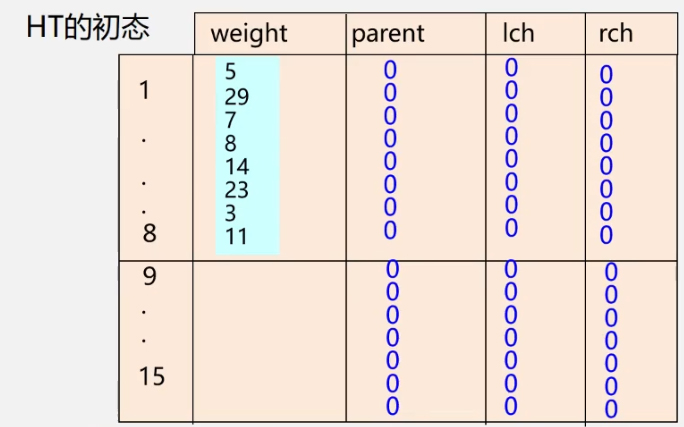
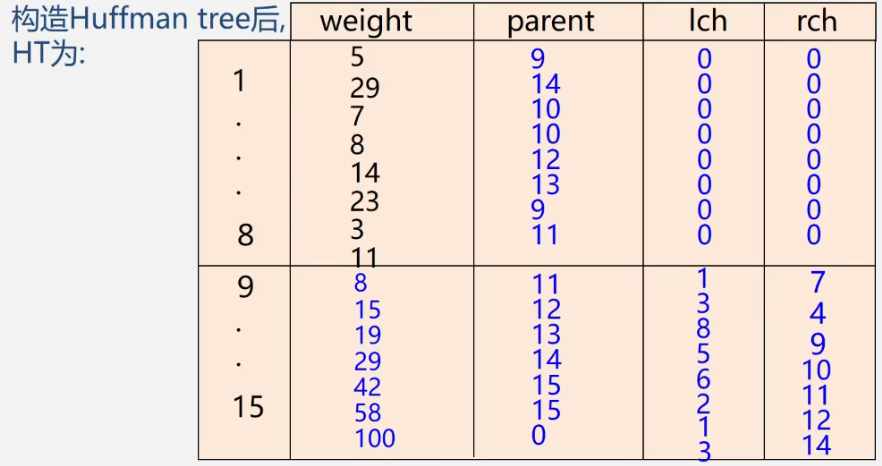
Huffman coding
Question: what prefix code can make the total length of the message shortest—— Huffman coding
- Count the average probability of each character in the character set appearing in the message (the greater the probability, the shorter the code is required)
- Using the characteristics of Huffman tree: the greater the weight, the closer the leaf is to the root; Taking the probability value of each character as the weight to construct Huffman tree, the node with higher probability will have shorter path
- Mark 0 or 1 on each branch of Huffman tree:
node left branch mark 0, right branch mark 1
connect the labels on the path from the root to each leaf as the encoding of the characters represented by the leaf
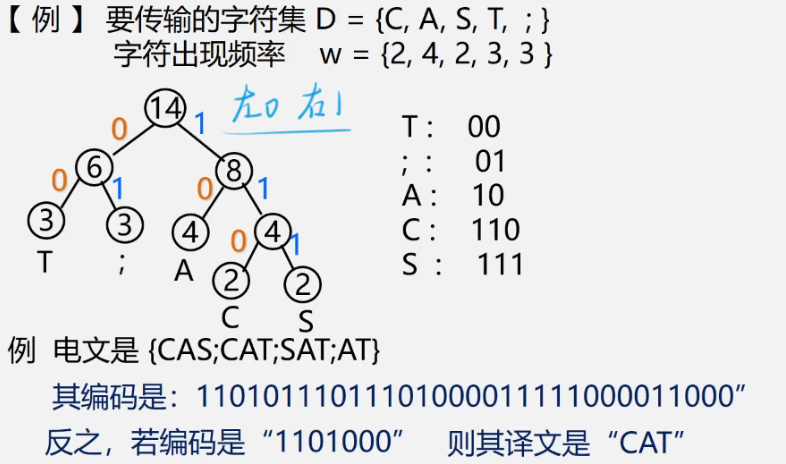

Explanation of Huffman coding algorithm: https://www.bilibili.com/video/BV1nJ411V7bdp=106&spm_id_from=pageDriver
Implementation of Huffman coding algorithm:
//The Huffman code of each character is obtained from the leaf to the inverse root and stored in the coding table HC
void CreatHuffmanCode(HuffmanTree HT, HuffmanCode &HC, int n){
HC = new char *[n + 1]; //Allocate n character encoded header pointer vectors
cd = new char [n]; //Allocate dynamic array space for temporarily storing codes
cd[n - 1] = '\0' ; //Code Terminator
for(i = 1; i <= n; ++i){ //Huffman coding character by character
start = n - 1;
c = i;
f = HT[i].parent;
while(f != 0){ //Trace back from the leaf node to the root node
--start; //Backtracking once start points forward to a position
if(HT[f].lchild == c) //If node c is the left child of f, the production code is 0
cd[start] = '0' ;
else //If node c is the right child of f, code 1 is generated
cd[start] = '1' ;
c = f; //Keep going back up
f = HT[f].parent;
} //Find the coding of the ith character
HC[i] = new char [n - start]; //Allocate space for the ith string encoding
strcpy(HC[i], &cd[start]); //Copy the obtained code from the temporary space cd to the current line of HC
}
delete cd; //Free up temporary space
} //CreatHuffanCode
Encoding and decoding of documents
1, Code:
① input each character and its weight
② construct Huffman tree - HT[i]
③ Huffman coding - HC[i]
④ check HC[i] to get Huffman code of each character
2, Decoding:
① construct Huffman tree
② read in binary codes in sequence
③ read 0 and go to the left child; Read 1 and go to the right child
④ once a leaf is reached, characters can be translated
⑤ then continue decoding from the root until the end
Explanation: https://www.bilibili.com/video/BV1nJ411V7bd?p=107